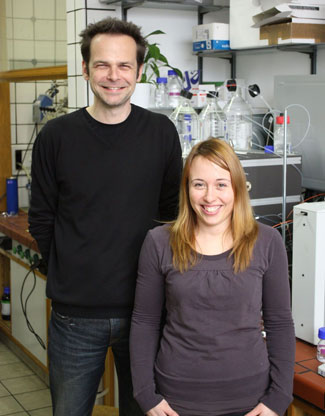| May 02, 2011 |
Chemists monitor single-molecule switching in action
|
|
(Nanowerk News) In various ways, bacteria are one step ahead to us humans. For example, they dispose of "intelligent" RNA molecules, so-called riboswitches, which help to regulate many of their essential metabolism pathways. The riboswitches, only discovered a few years ago, are sensors in RNA molecules. A riboswitch acts similarly to a motion sensor that switches on or off the light when people are nearby: the riboswitch switches genes off or on when certain metabolism products are present in a cell. There is no similar mechanism of gene regulation in humans, therefore this represents an ideal target for new antibiotics.
|
|
However, how the sensoring and switching process is transduced has remained widely unexplained since the discovery of riboswitches. Now, an international team under the leadership of chemists from Innsbruck succeeded in monitoring the S-adenosylmethionine (SAM) II-riboswitch in action. SAM is a cofactor which is involved in many metabolism processes by transferring methyl groups to other molecules.
|
|
Molecules are twitchy
|
|
The scientists Andrea Haller and Ronald Micura from the Institute of Organic Chemistry and the Center for Molecular Biosciences of the University of Innsbruck, together with Scott Blanchard from the Weill Cornell Medical College in New York, recorded the movements of single riboswitch molecules by using a technique called smFRET (single-molecule Fluorescence Resonance Energy Transfer).
|
 |
| Ronald Micura and Andrea Haller
|
|
This was reported by the journal Nature Chemical Biology in today's online issue ("Conformational capture of the SAM-II riboswitch"). The scientists discovered that SAM II-riboswitches are extremely "twitchy" molecules, undergoing immensely fast structure changes. "The key to understanding their function lies just in these dynamics", Micura explains. His team's work was done in line with the GEN-AU project for non-coding RNAs which is managed by Innsbruck's company CEMIT (for more information see below) and also supported by the Austrian Science Fund FWF.
|
|
The switching is constantly simulated
|
|
The SAM II-riboswitch switches off when a SAM molecule binds to it. Then it forms a structure where the genetic information is not accessible any more. By means of the smFRET technique and other methods, Micura's team was able to analyze for the first time in detail what is happening at the time of the binding event. As expected, they noticed that the free riboswitch has an open structure at first, where the genetic information is easily accessible. However, the riboswitch simulates constantly the switching action even when there is no SAM molecule nearby. The riboswitch is swinging back and forth in microseconds time scale between the open structure and a state which resembles the off-state. When a SAM molecule appears, it binds to the "nearly-off-state", a minimal change in structure occurs, and the switch is finally turned off. Hence, the structure becomes fixed.
|
|
Single molecules establish a new dimension for research
|
|
Micura and his team are thrilled about this discovery. Just now, in the International Year of Chemistry 2011, it becomes more apparent that this is far from a disenchanted science whose mysteries are unraveled. On the contrary: knowledge was used to rely mostly on mean data which were measured in a great number of molecules simultaneously. Today it is technically feasible to monitor single molecules and observe their individual behavior. "This is a completely new dimension for research and extremely exciting", says Micura.
|

